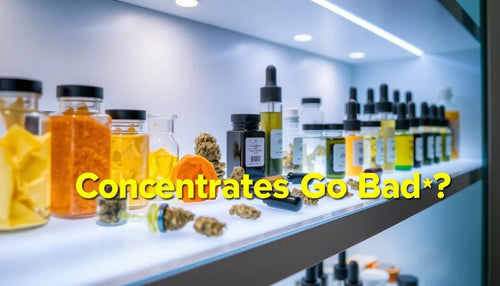Marijuana concentrates are sensitive and have the potential to go bad if they are not kept properly. Factors such as temperature, humidity, and light are very important to maintain their stability.

Getting familiar with storage, the composition, and the ways of spoilage greatly contributes to the better usage of cannabis extracts.
What are Marijuana Concentrates and Their Composition
Cannabis concentrates are a strong and advanced way to use cannabis. They take the key parts of the cannabis plant and pack them into refined products. This includes the important cannabinoids and terpenes.

The universe of cannabis concentrates is pretty huge and complicated. It has in it many methods of producing and consuming them.
Typical Types of Cannabis Concentrates
- Shatter: A concentrate that is clear, has a look of the glass, and a very high THC content
- Wax: A soft, white limited extract with a texture that is easily shaped
- Oil: A liquid concentrate which is a source of a dry vaporizer
- Rosin: A clean, solvent-free extract made with heat and pressure
- Live Resin: Obtaining the extract from the fresh, frozen cannabis plants
Chemical Structure and Stability
Stability of THC is of utmost importance, and it largely depends on several factors. Nature of temperature, light, and humidity are among the factors that influence the stability of cannabis concentrates.
| Concentrate Type | Average THC Percentage | Stability Rating |
|---|---|---|
| Shatter | 70-90% | High |
| Wax | 60-80% | Medium |
| Oil | 50-70% | Low |
Understanding Cannabis Concentrates
- One of the major components of cannabis, THC, is generally known, but concentrates have other vital compounds such as CBD, CBG, and terpenes besides THC.
- These supplementary compounds are the main source of the changes and the positives that a concentrate can bring to a user's health, they are the direct contributors to the overall effects that a concentrate has and its potential health benefit.
- Where Different Chemicals Come From: Different chemical compositions of the products result from different methods of extraction, which basically determine the final chemical makeup.
Signs of Deteriorating Cannabis Concentrates
Cannabis concentrates can degrade over time. It's important to know when they go bad. This way, you can avoid using spoiled products that might harm your health or experience.

One of the foremost indicators for a visual glance is the point where the concentrated products become spoiled. Here are some of the signs you should watch for:
Unconventional colors changing from the original amber or golden hues
- Forming of crystals or separation of compounds
- An opaque or murky look
- Extreme changes in the texture
Besides that, sensory indicators are also very important. Concentrates that are potent and fresh have a nice, strong, and vibrant smell. When they become old, they can emit a musty or stale scent.
- Musty or stale odors
- Reduced terpene profiles
- Smelling that is harsh or unpleasant
Moreover, a reduction of potency is another indication. Inflammable extracts can become weakened over time. In this case, they will not bring you the same effects.
Factors Affecting Cannabis Concentrate Quality
Cannabis concentrates are delicate and need careful storage. Their quality and potency can drop quickly if stored badly. 
Temperature and Environmental Impact
When there is too much heat, cannabinoids can break down and that means a less effective product. The ideal storage temperature is from 50 to 70°F with little or no change.
If temperature changes quickly, it can cause moisture. The moisture can become a source of bacteria that are dangerous to health.
- Proper temperature range: 50-70°F
- Do not expose to direct sunlight
- Away from kitchen appliances
- Keep in cool and dark places
Light Exposure Effects
Ultraviolet light is unfavorable for cannabis products. Natural light or powerful artificial light may cause the breakdown of cannabinoids and terpenes. It makes the product less potent and flavorful.
Humidity Control Importance
Without a doubt, the proper management of the humidity is what makes the quality of the concentrates possible. Excessive moisture can bring mold to the product, while lack of moisture can cause the loss of terpenes.
| Humidity Level | Impact on Concentrates |
|---|---|
| Below 55% | Risk of terpene degradation |
| 55-62% | Ideal storage conditions |
| Above 65% | Potential mold growth |
Users should use airtight, dark containers with humidity control. This helps keep concentrates fresh and potent for longer.
Can Marijuana Concentrates Go Bad?
Marijuana concentrate can become stale and the flavors less vibrant or the potency lessened with time. Those who use concentrates, as in dabbing, ought to know this risk.

Different types of concentrates have different shelf lives. Some signs that a concentrate has gone bad include:
- Changes in color and consistency
- Loss of potency
- Unusual odor or taste
- Visible mold or contamination
The rate at which concentrates deteriorate can be influenced by storage conditions. Exposure to heat, light, and oxygen can speed up the breakdown of active compounds. Terpenes and cannabinoids are very sensitive to changes in their environment.
| Concentrate Type | Average Shelf Life | Storage Recommendation |
|---|---|---|
| Live Resin | 6-12 months | Cool, dark place |
| Shatter | 1-2 years | Airtight container |
| Wax | 3-6 months | Refrigerated |
While concentrates can technically "go bad," proper storage can extend their use.
Proper Storage Methods for Cannabis Concentrates
Freshness of marijuana extracts is a matter of proper storage. Proper storage of cannabis products is what keeps them potent, tasty, and of high quality.

First of all, the most essential factor in the safeguarding of your marijuana is the appropriate containers. Various kinds of concentrates must be kept in various manners so as not to be ruined.
Best Storage Containers for Concentrates
- Non-stick silicone containers for live resin and sauce
- Glass containers with airtight seals for most extract types
- Glass that is resistant to UV rays for complete protection from the light
- Small and compact containers to reduce air exposure to the minimum
Optimal Storage Conditions
| Condition | Recommended Setting | Impact on Concentrate |
|---|---|---|
| Temperature | 60-70°F (15-21°C) | Prevents degradation of cannabinoids |
| Humidity | 55-62% relative humidity | Prevents mold and preserve terpene profile |
| Light Exposure | Minimal to none | Protects from UV degradation |
Long-term Preservation Techniques
For long storage, try these methods:
- Refrigeration at consistent temperatures
- Vacuum-sealed storage
- Freezing for extremely long-term storage

